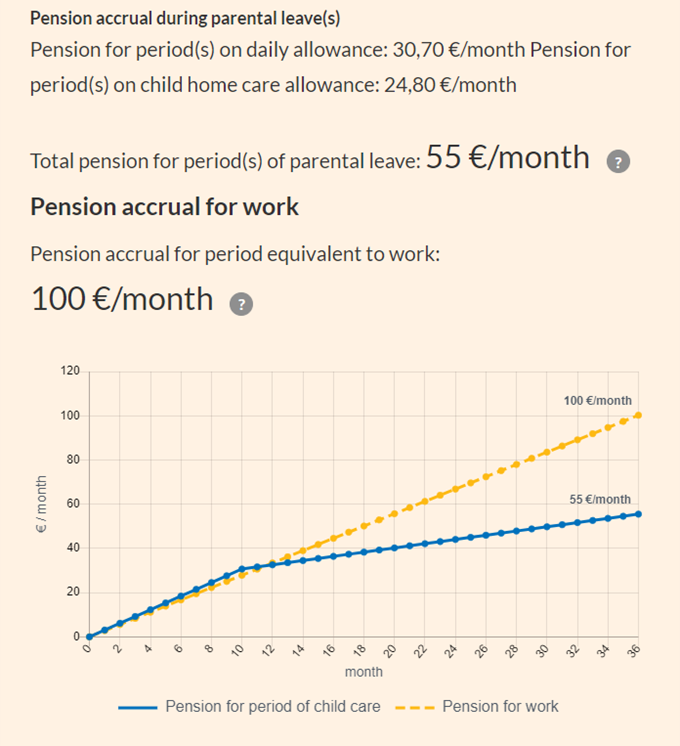Bridging the gender pension gap: Insights from Finland
Despite Finland’s reputation for equality, the gender pension gap is significant in the country. An online calculator has been launched to tackle the gap by providing information on how family leave affects pension accrual. While the tool provides useful information, its impact remains limited. Bridging the gender pension gap will require tackling the wider gender pay gap.
Along with the other Nordic countries, Finland is considered one of the most gender-equal countries in the world. Nevertheless, the gender pension gap remains significant, with women’s monthly pensions on average one fifth lower than men’s.
The unequal distribution of family leave is a key factor in this gap. A recent study of Finns born in 1980 revealed that, by the age of 36, mothers’ career breaks due to family leave were 13 times longer than fathers’. While parents can theoretically share the majority of family leave days, mothers shoulder around 90 per cent of this responsibility.
Online calculator provides an indication of how family leave affects pensions
To address the gender pension gap in Finland, an innovative online tool was launched as part of the project “Promoting gender equality in pension”. The user-friendly pension calculator maintained by the Finnish Centre for Pensions requires minimal information: year of birth, income in the previous month or year, and the total number of months of parental allowance and child home care allowance.
The pension system in Finland is comprehensive and simple compared with many other countries. Thestatutory earnings-related pension scheme covers nearly all paid work, and the conditions for receiving benefits have been harmonized. As all employees are insured according to the same rules, it was relatively easy to develop this online tool. As the role of 2nd and 3rd pillar pensions is marginal in Finland, the calculator can provide most Finns with a broad understanding of how family leave affects their pensions.
Pension accrual is higher from parental leave than from working, but the longer the period on child home care allowance, the greater the loss
Let’s delve into specifics. The results are calculated for a person born in 1995 (average age at first birth is 29), whose previous monthly gross income was 2,500 euros (the average income in this age group), and who takes the maximum duration of family leave. The calculator provides illustrative, indicative information.

During pregnancy and a 9-month parental leave, the amount of the pension accrued is slightly higher than when working because pension accrues based on annual earnings which have been increased by 21 per cent.
After parental leave, one can stay at home with a flat-rate child home care allowance until the child turns three. Pension still accrues during this period, but there is a clear loss in pension accrual, as the home care allowance period is credited based on a fixed income of 857.15 euros per month (in 2024).
The longer the time spent at home with a child home care allowance, the greater the loss compared to working.
The online calculator provides useful information with limited impact
The use of the calculator is regularly monitored. Over 80 per cent of those who have used the calculator have found it helpful in estimating the impact of family leave on their pension. This is important as many people are unaware that pension accrues during family leave.
More than 40 per cent of the users of the calculator stated that the information they received from the calculator influenced their decision about the length of their family leave. Thus, the calculator not only provides helpful information but also impacts behavior.
However, almost 40 per cent of the users said that knowing how family leave affects their pension had no impact on their chosen length of family leave. Additionally, the calculator is not widely used, which limits its impact. Action is needed to improve the use of the calculator.
Family leaves were recently reformed to encourage both parents to stay at home with their children and to increase equality in working life. The impact of these changes will be seen over time.
Action is needed to tackle the wide gender pay gap
Even though unequal sharing of family leave is one of the reasons for the gender pension gap, gender inequalities in the labour market pose the main challenge. Women tend to take more parental leave, but by the time they retire, the length of their working careers is almost equal to that of men’s. The main driver of the gender pension gap is the wide gap in earnings over the life course.
The labour market in Finland is highly segregated, with only one in ten employees working in so-called gender-equal occupations, where the proportion of men and women is between 40 and 60 per cent. Nine in ten employees work in jobs typical of their gender. Wages for typical jobs for women are on average much lower than those of men. This is the main reason for the gender pension gap. Women also tend to be penalised for having children and work more part-time and less overtime.
The gender pension gap is not only about inequality in family care but about inequality in the labour market in general. As long as these structural causes persist, the gender gap will also persist.
Explore the Finnish Centre for Pensions’ calculator for periods of family leave (Työeläke.fi)
This blog is based on an invited presentation at the Belgian Presidency of the European Union High-Level Conference on Gender Pension Gap and Pension Adequacy, where the Finnish good practices were presented. Read the Report of the High-Level Conference on the Gender Pension Gap & Pension Adequacy (Belgium.be)
The project Promoting gender equality in pensions received funding from the EU’s Rights Equality and Citizenship Programme (2014–2020) and was led by the Ministry of Social Affairs and Health. The overall aim of the project was to raise awareness among people and decision-makers about the reasons for the pension gap.
